Managing Projects Report: Leadership and Project Cycle Analysis
VerifiedAdded on 2023/02/02
|12
|3794
|34
Report
AI Summary
This report delves into the core aspects of project management, using a case study of Hotel Communications Ltd. The report begins by outlining the characteristics of a project, its scope, and the use of tools like Gantt charts and budgets. It then explores risk responses and quality methods essential for project success. The second part of the report focuses on the skills and competencies required by project teams, highlighting the importance of time management, leadership, communication, and problem-solving. Different leadership styles, including situational, autocratic, transformational, and democratic approaches, are analyzed for their impact on project outcomes. Finally, the report examines the project management cycle and administrative challenges, offering a comprehensive overview of project management principles and practices.
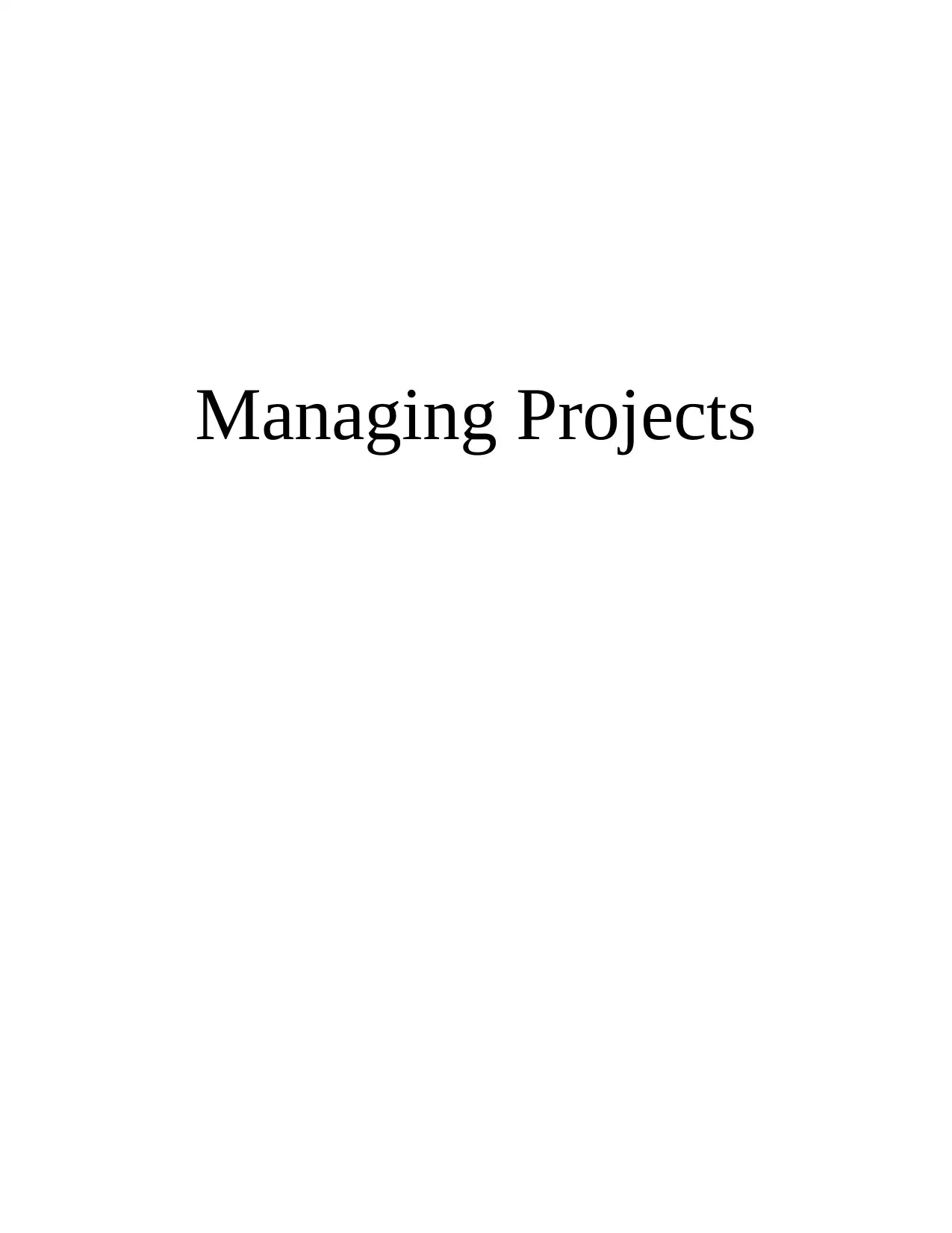
Managing Projects
Paraphrase This Document
Need a fresh take? Get an instant paraphrase of this document with our AI Paraphraser
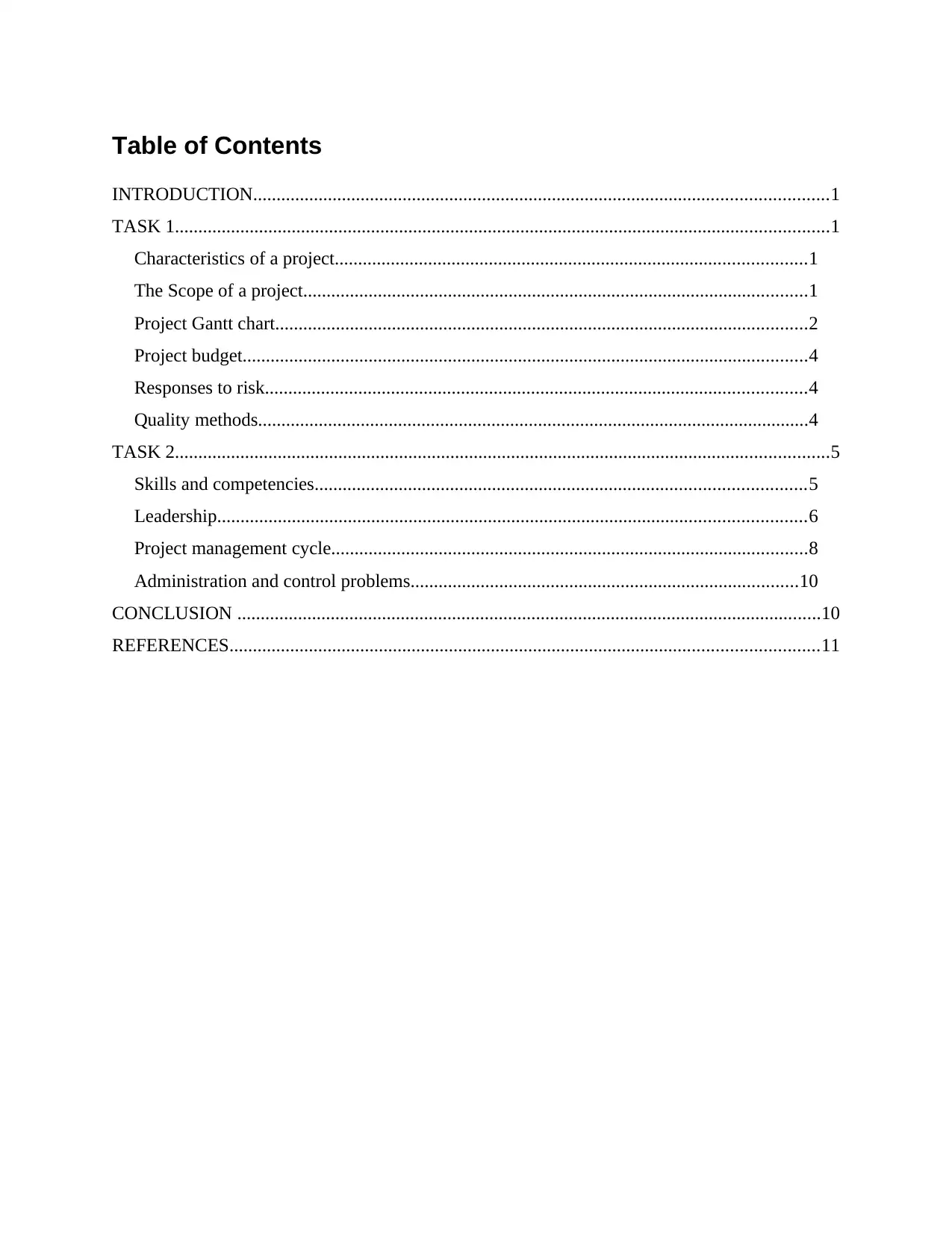
Table of Contents
INTRODUCTION...........................................................................................................................1
TASK 1............................................................................................................................................1
Characteristics of a project.....................................................................................................1
The Scope of a project............................................................................................................1
Project Gantt chart..................................................................................................................2
Project budget.........................................................................................................................4
Responses to risk....................................................................................................................4
Quality methods......................................................................................................................4
TASK 2............................................................................................................................................5
Skills and competencies.........................................................................................................5
Leadership..............................................................................................................................6
Project management cycle......................................................................................................8
Administration and control problems...................................................................................10
CONCLUSION .............................................................................................................................10
REFERENCES..............................................................................................................................11
INTRODUCTION...........................................................................................................................1
TASK 1............................................................................................................................................1
Characteristics of a project.....................................................................................................1
The Scope of a project............................................................................................................1
Project Gantt chart..................................................................................................................2
Project budget.........................................................................................................................4
Responses to risk....................................................................................................................4
Quality methods......................................................................................................................4
TASK 2............................................................................................................................................5
Skills and competencies.........................................................................................................5
Leadership..............................................................................................................................6
Project management cycle......................................................................................................8
Administration and control problems...................................................................................10
CONCLUSION .............................................................................................................................10
REFERENCES..............................................................................................................................11
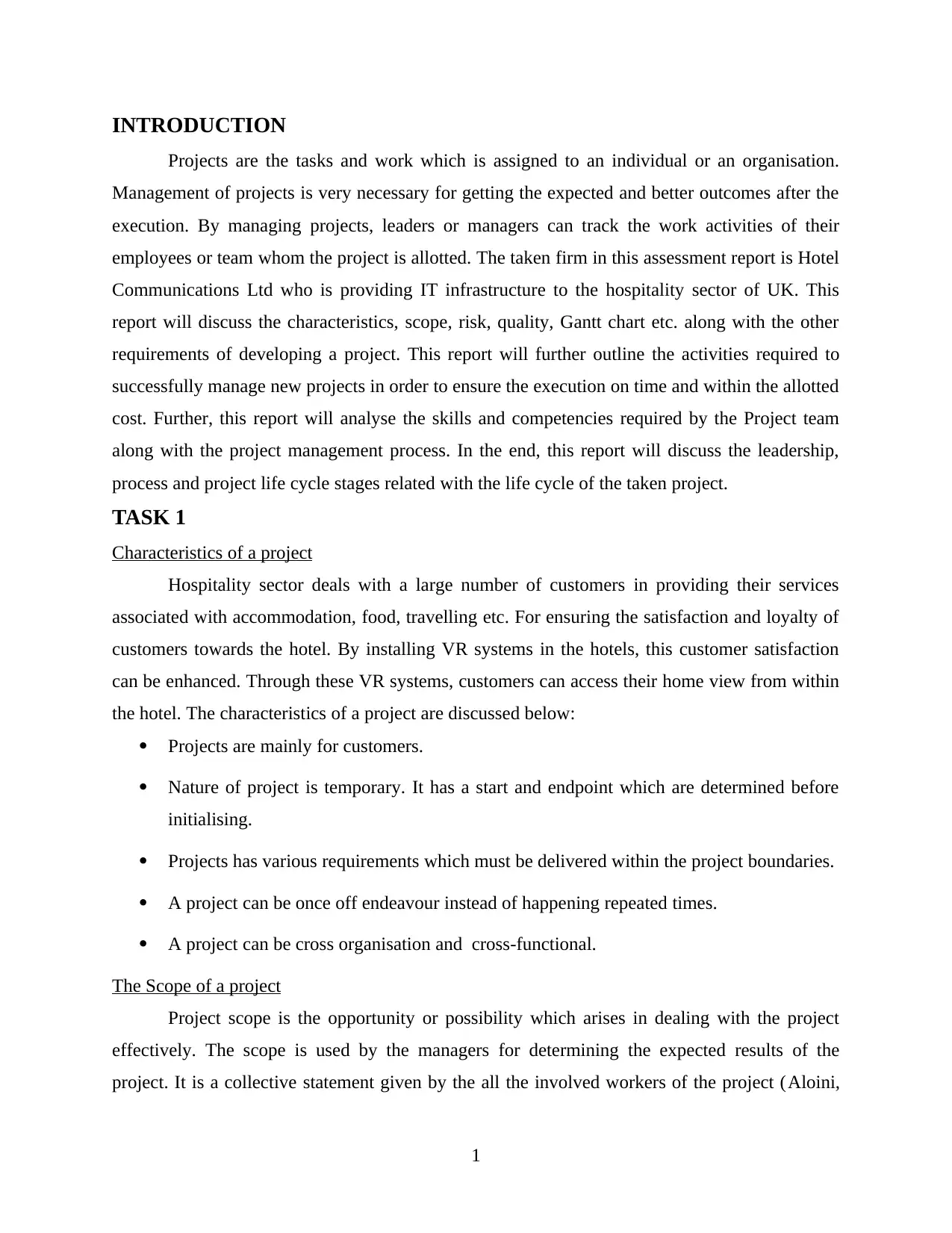
INTRODUCTION
Projects are the tasks and work which is assigned to an individual or an organisation.
Management of projects is very necessary for getting the expected and better outcomes after the
execution. By managing projects, leaders or managers can track the work activities of their
employees or team whom the project is allotted. The taken firm in this assessment report is Hotel
Communications Ltd who is providing IT infrastructure to the hospitality sector of UK. This
report will discuss the characteristics, scope, risk, quality, Gantt chart etc. along with the other
requirements of developing a project. This report will further outline the activities required to
successfully manage new projects in order to ensure the execution on time and within the allotted
cost. Further, this report will analyse the skills and competencies required by the Project team
along with the project management process. In the end, this report will discuss the leadership,
process and project life cycle stages related with the life cycle of the taken project.
TASK 1
Characteristics of a project
Hospitality sector deals with a large number of customers in providing their services
associated with accommodation, food, travelling etc. For ensuring the satisfaction and loyalty of
customers towards the hotel. By installing VR systems in the hotels, this customer satisfaction
can be enhanced. Through these VR systems, customers can access their home view from within
the hotel. The characteristics of a project are discussed below:
Projects are mainly for customers.
Nature of project is temporary. It has a start and endpoint which are determined before
initialising.
Projects has various requirements which must be delivered within the project boundaries.
A project can be once off endeavour instead of happening repeated times.
A project can be cross organisation and cross-functional.
The Scope of a project
Project scope is the opportunity or possibility which arises in dealing with the project
effectively. The scope is used by the managers for determining the expected results of the
project. It is a collective statement given by the all the involved workers of the project (Aloini,
1
Projects are the tasks and work which is assigned to an individual or an organisation.
Management of projects is very necessary for getting the expected and better outcomes after the
execution. By managing projects, leaders or managers can track the work activities of their
employees or team whom the project is allotted. The taken firm in this assessment report is Hotel
Communications Ltd who is providing IT infrastructure to the hospitality sector of UK. This
report will discuss the characteristics, scope, risk, quality, Gantt chart etc. along with the other
requirements of developing a project. This report will further outline the activities required to
successfully manage new projects in order to ensure the execution on time and within the allotted
cost. Further, this report will analyse the skills and competencies required by the Project team
along with the project management process. In the end, this report will discuss the leadership,
process and project life cycle stages related with the life cycle of the taken project.
TASK 1
Characteristics of a project
Hospitality sector deals with a large number of customers in providing their services
associated with accommodation, food, travelling etc. For ensuring the satisfaction and loyalty of
customers towards the hotel. By installing VR systems in the hotels, this customer satisfaction
can be enhanced. Through these VR systems, customers can access their home view from within
the hotel. The characteristics of a project are discussed below:
Projects are mainly for customers.
Nature of project is temporary. It has a start and endpoint which are determined before
initialising.
Projects has various requirements which must be delivered within the project boundaries.
A project can be once off endeavour instead of happening repeated times.
A project can be cross organisation and cross-functional.
The Scope of a project
Project scope is the opportunity or possibility which arises in dealing with the project
effectively. The scope is used by the managers for determining the expected results of the
project. It is a collective statement given by the all the involved workers of the project (Aloini,
1
⊘ This is a preview!⊘
Do you want full access?
Subscribe today to unlock all pages.

Trusted by 1+ million students worldwide
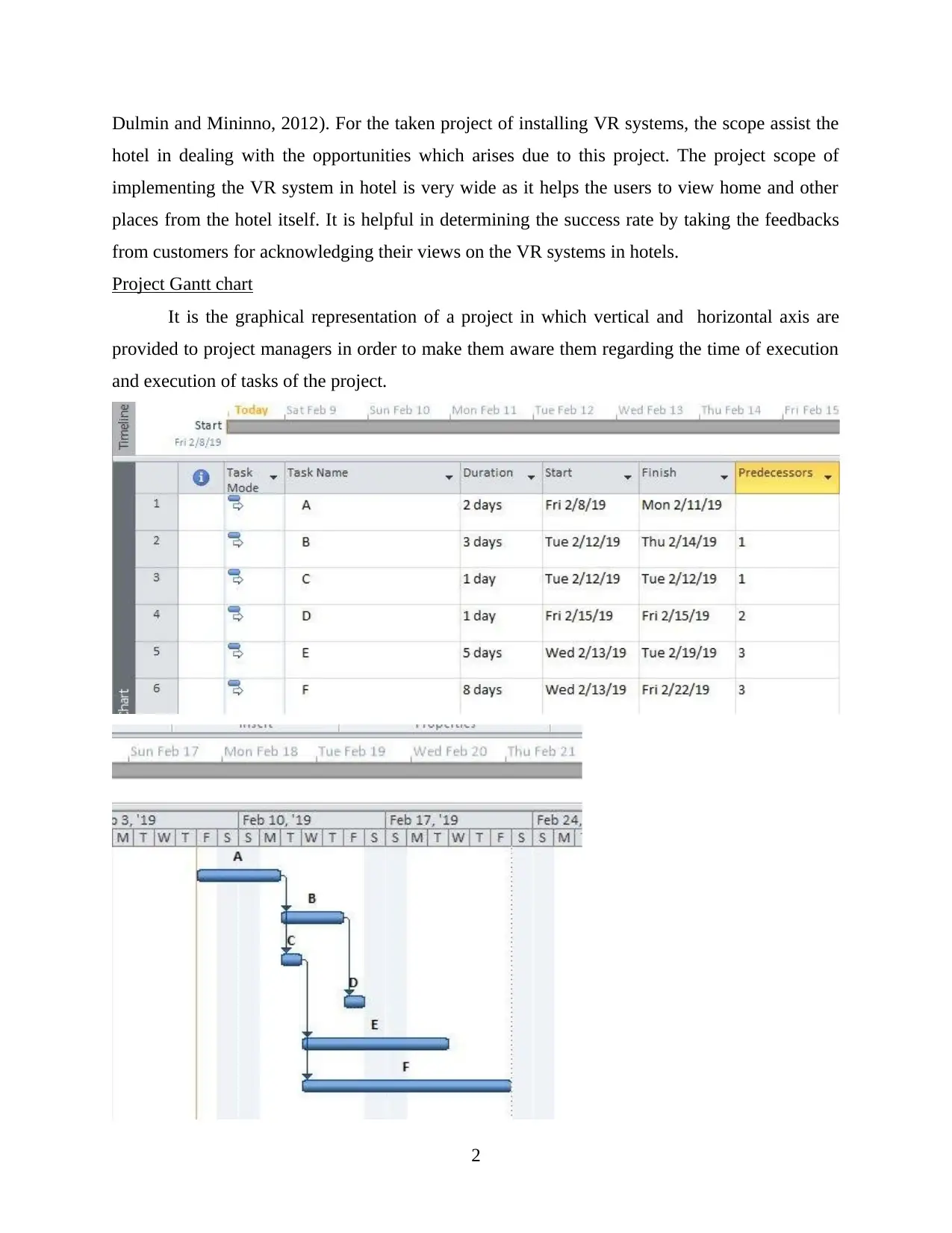
Dulmin and Mininno, 2012). For the taken project of installing VR systems, the scope assist the
hotel in dealing with the opportunities which arises due to this project. The project scope of
implementing the VR system in hotel is very wide as it helps the users to view home and other
places from the hotel itself. It is helpful in determining the success rate by taking the feedbacks
from customers for acknowledging their views on the VR systems in hotels.
Project Gantt chart
It is the graphical representation of a project in which vertical and horizontal axis are
provided to project managers in order to make them aware them regarding the time of execution
and execution of tasks of the project.
2
hotel in dealing with the opportunities which arises due to this project. The project scope of
implementing the VR system in hotel is very wide as it helps the users to view home and other
places from the hotel itself. It is helpful in determining the success rate by taking the feedbacks
from customers for acknowledging their views on the VR systems in hotels.
Project Gantt chart
It is the graphical representation of a project in which vertical and horizontal axis are
provided to project managers in order to make them aware them regarding the time of execution
and execution of tasks of the project.
2
Paraphrase This Document
Need a fresh take? Get an instant paraphrase of this document with our AI Paraphraser
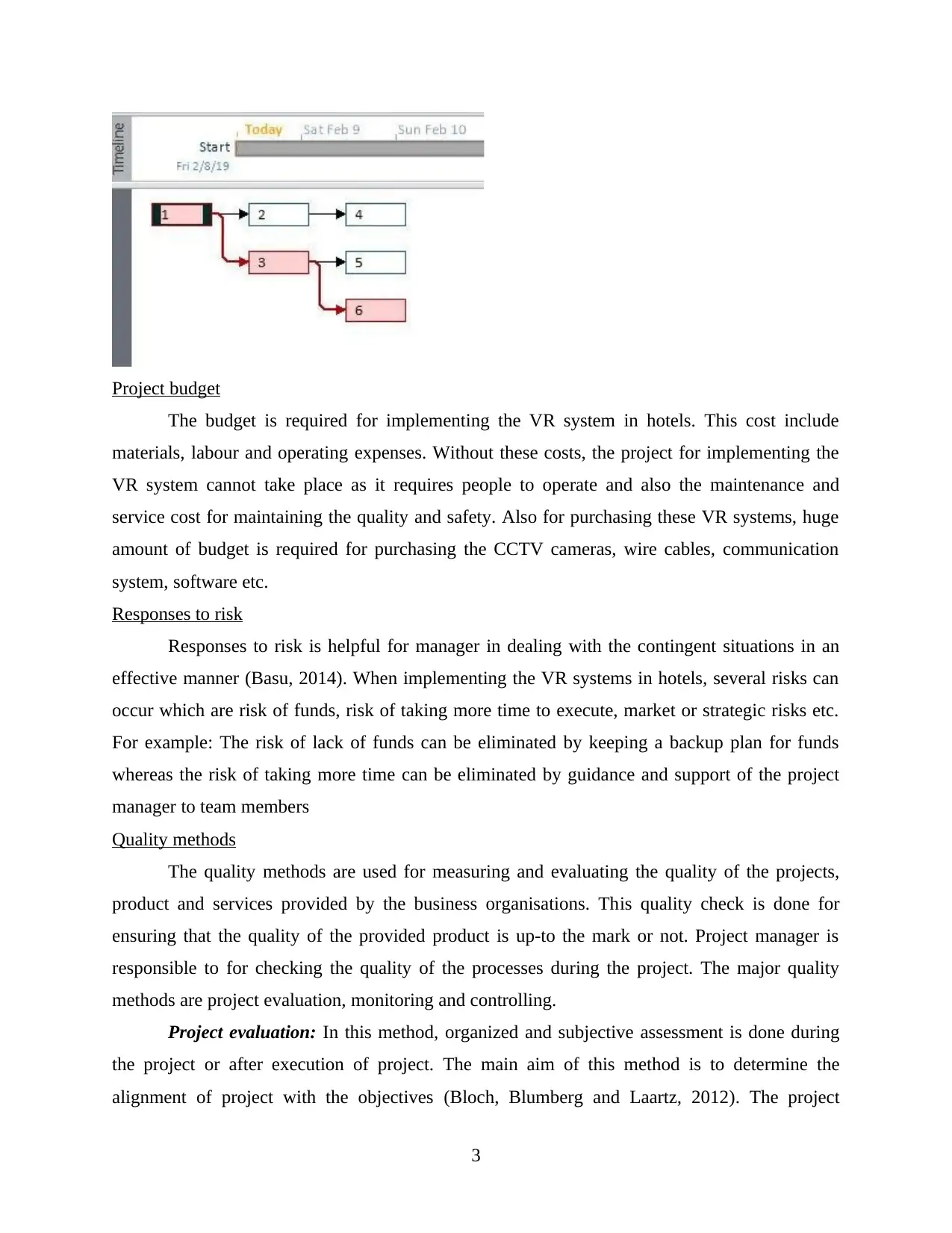
Project budget
The budget is required for implementing the VR system in hotels. This cost include
materials, labour and operating expenses. Without these costs, the project for implementing the
VR system cannot take place as it requires people to operate and also the maintenance and
service cost for maintaining the quality and safety. Also for purchasing these VR systems, huge
amount of budget is required for purchasing the CCTV cameras, wire cables, communication
system, software etc.
Responses to risk
Responses to risk is helpful for manager in dealing with the contingent situations in an
effective manner (Basu, 2014). When implementing the VR systems in hotels, several risks can
occur which are risk of funds, risk of taking more time to execute, market or strategic risks etc.
For example: The risk of lack of funds can be eliminated by keeping a backup plan for funds
whereas the risk of taking more time can be eliminated by guidance and support of the project
manager to team members
Quality methods
The quality methods are used for measuring and evaluating the quality of the projects,
product and services provided by the business organisations. This quality check is done for
ensuring that the quality of the provided product is up-to the mark or not. Project manager is
responsible to for checking the quality of the processes during the project. The major quality
methods are project evaluation, monitoring and controlling.
Project evaluation: In this method, organized and subjective assessment is done during
the project or after execution of project. The main aim of this method is to determine the
alignment of project with the objectives (Bloch, Blumberg and Laartz, 2012). The project
3
The budget is required for implementing the VR system in hotels. This cost include
materials, labour and operating expenses. Without these costs, the project for implementing the
VR system cannot take place as it requires people to operate and also the maintenance and
service cost for maintaining the quality and safety. Also for purchasing these VR systems, huge
amount of budget is required for purchasing the CCTV cameras, wire cables, communication
system, software etc.
Responses to risk
Responses to risk is helpful for manager in dealing with the contingent situations in an
effective manner (Basu, 2014). When implementing the VR systems in hotels, several risks can
occur which are risk of funds, risk of taking more time to execute, market or strategic risks etc.
For example: The risk of lack of funds can be eliminated by keeping a backup plan for funds
whereas the risk of taking more time can be eliminated by guidance and support of the project
manager to team members
Quality methods
The quality methods are used for measuring and evaluating the quality of the projects,
product and services provided by the business organisations. This quality check is done for
ensuring that the quality of the provided product is up-to the mark or not. Project manager is
responsible to for checking the quality of the processes during the project. The major quality
methods are project evaluation, monitoring and controlling.
Project evaluation: In this method, organized and subjective assessment is done during
the project or after execution of project. The main aim of this method is to determine the
alignment of project with the objectives (Bloch, Blumberg and Laartz, 2012). The project
3
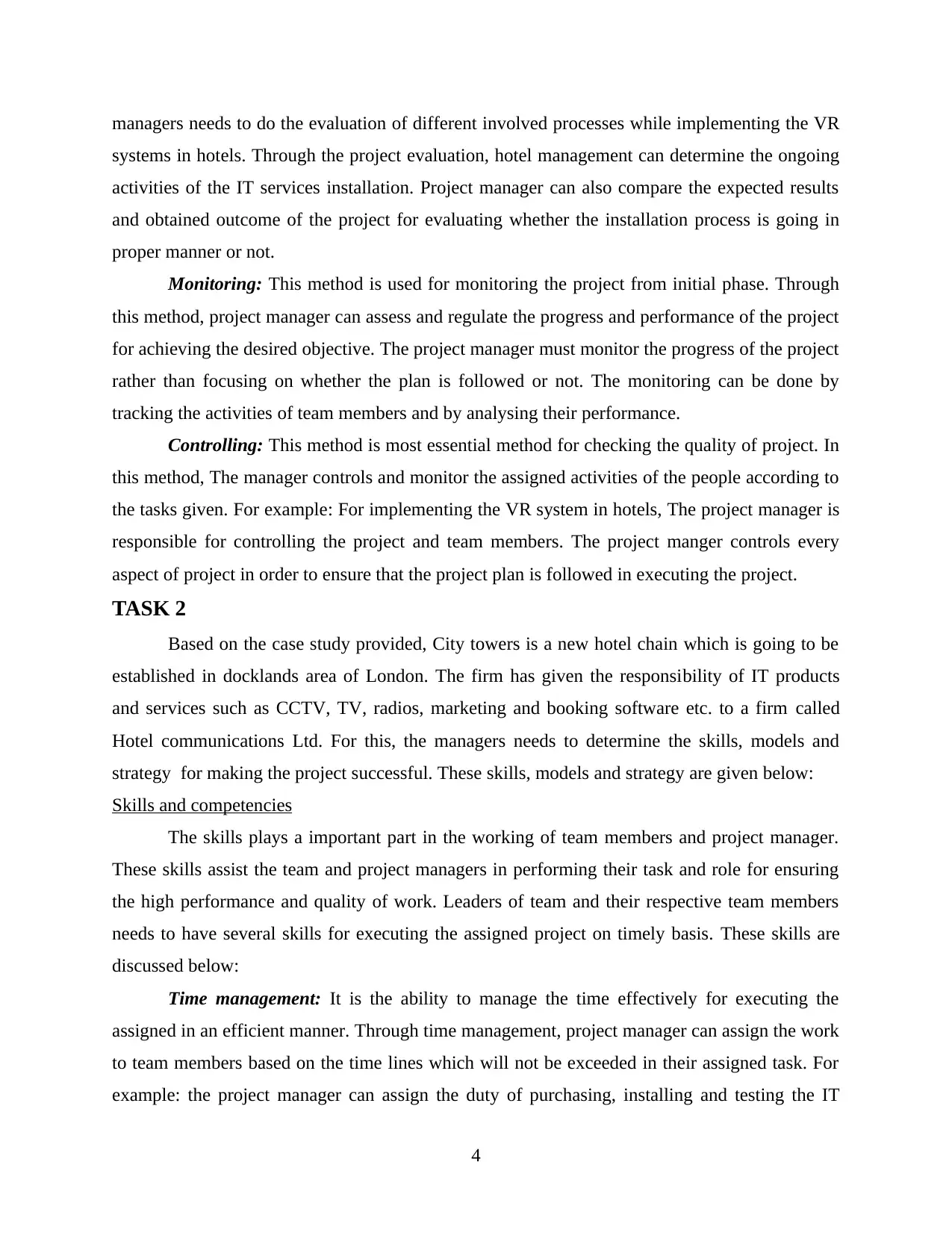
managers needs to do the evaluation of different involved processes while implementing the VR
systems in hotels. Through the project evaluation, hotel management can determine the ongoing
activities of the IT services installation. Project manager can also compare the expected results
and obtained outcome of the project for evaluating whether the installation process is going in
proper manner or not.
Monitoring: This method is used for monitoring the project from initial phase. Through
this method, project manager can assess and regulate the progress and performance of the project
for achieving the desired objective. The project manager must monitor the progress of the project
rather than focusing on whether the plan is followed or not. The monitoring can be done by
tracking the activities of team members and by analysing their performance.
Controlling: This method is most essential method for checking the quality of project. In
this method, The manager controls and monitor the assigned activities of the people according to
the tasks given. For example: For implementing the VR system in hotels, The project manager is
responsible for controlling the project and team members. The project manger controls every
aspect of project in order to ensure that the project plan is followed in executing the project.
TASK 2
Based on the case study provided, City towers is a new hotel chain which is going to be
established in docklands area of London. The firm has given the responsibility of IT products
and services such as CCTV, TV, radios, marketing and booking software etc. to a firm called
Hotel communications Ltd. For this, the managers needs to determine the skills, models and
strategy for making the project successful. These skills, models and strategy are given below:
Skills and competencies
The skills plays a important part in the working of team members and project manager.
These skills assist the team and project managers in performing their task and role for ensuring
the high performance and quality of work. Leaders of team and their respective team members
needs to have several skills for executing the assigned project on timely basis. These skills are
discussed below:
Time management: It is the ability to manage the time effectively for executing the
assigned in an efficient manner. Through time management, project manager can assign the work
to team members based on the time lines which will not be exceeded in their assigned task. For
example: the project manager can assign the duty of purchasing, installing and testing the IT
4
systems in hotels. Through the project evaluation, hotel management can determine the ongoing
activities of the IT services installation. Project manager can also compare the expected results
and obtained outcome of the project for evaluating whether the installation process is going in
proper manner or not.
Monitoring: This method is used for monitoring the project from initial phase. Through
this method, project manager can assess and regulate the progress and performance of the project
for achieving the desired objective. The project manager must monitor the progress of the project
rather than focusing on whether the plan is followed or not. The monitoring can be done by
tracking the activities of team members and by analysing their performance.
Controlling: This method is most essential method for checking the quality of project. In
this method, The manager controls and monitor the assigned activities of the people according to
the tasks given. For example: For implementing the VR system in hotels, The project manager is
responsible for controlling the project and team members. The project manger controls every
aspect of project in order to ensure that the project plan is followed in executing the project.
TASK 2
Based on the case study provided, City towers is a new hotel chain which is going to be
established in docklands area of London. The firm has given the responsibility of IT products
and services such as CCTV, TV, radios, marketing and booking software etc. to a firm called
Hotel communications Ltd. For this, the managers needs to determine the skills, models and
strategy for making the project successful. These skills, models and strategy are given below:
Skills and competencies
The skills plays a important part in the working of team members and project manager.
These skills assist the team and project managers in performing their task and role for ensuring
the high performance and quality of work. Leaders of team and their respective team members
needs to have several skills for executing the assigned project on timely basis. These skills are
discussed below:
Time management: It is the ability to manage the time effectively for executing the
assigned in an efficient manner. Through time management, project manager can assign the work
to team members based on the time lines which will not be exceeded in their assigned task. For
example: the project manager can assign the duty of purchasing, installing and testing the IT
4
⊘ This is a preview!⊘
Do you want full access?
Subscribe today to unlock all pages.

Trusted by 1+ million students worldwide
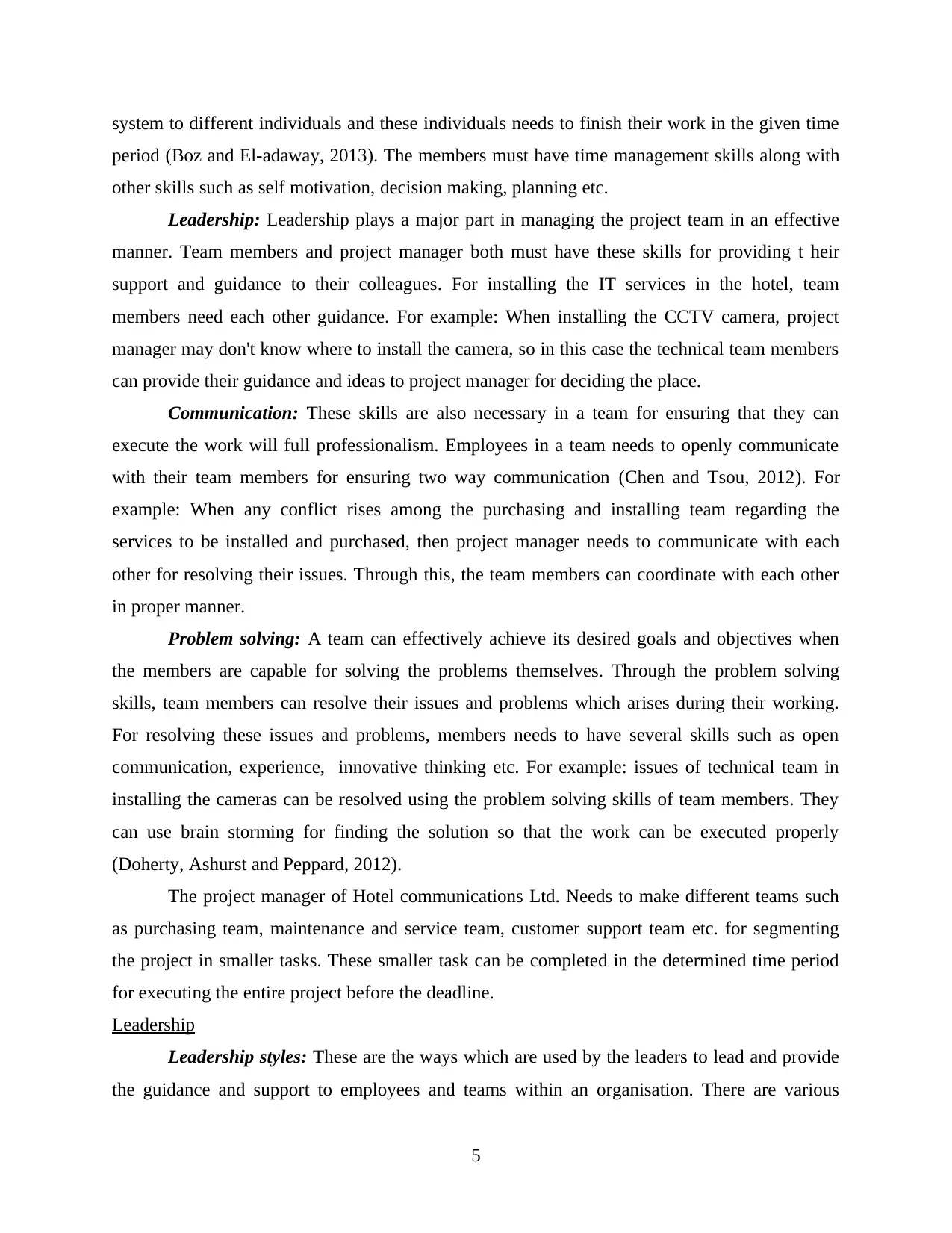
system to different individuals and these individuals needs to finish their work in the given time
period (Boz and El-adaway, 2013). The members must have time management skills along with
other skills such as self motivation, decision making, planning etc.
Leadership: Leadership plays a major part in managing the project team in an effective
manner. Team members and project manager both must have these skills for providing t heir
support and guidance to their colleagues. For installing the IT services in the hotel, team
members need each other guidance. For example: When installing the CCTV camera, project
manager may don't know where to install the camera, so in this case the technical team members
can provide their guidance and ideas to project manager for deciding the place.
Communication: These skills are also necessary in a team for ensuring that they can
execute the work will full professionalism. Employees in a team needs to openly communicate
with their team members for ensuring two way communication (Chen and Tsou, 2012). For
example: When any conflict rises among the purchasing and installing team regarding the
services to be installed and purchased, then project manager needs to communicate with each
other for resolving their issues. Through this, the team members can coordinate with each other
in proper manner.
Problem solving: A team can effectively achieve its desired goals and objectives when
the members are capable for solving the problems themselves. Through the problem solving
skills, team members can resolve their issues and problems which arises during their working.
For resolving these issues and problems, members needs to have several skills such as open
communication, experience, innovative thinking etc. For example: issues of technical team in
installing the cameras can be resolved using the problem solving skills of team members. They
can use brain storming for finding the solution so that the work can be executed properly
(Doherty, Ashurst and Peppard, 2012).
The project manager of Hotel communications Ltd. Needs to make different teams such
as purchasing team, maintenance and service team, customer support team etc. for segmenting
the project in smaller tasks. These smaller task can be completed in the determined time period
for executing the entire project before the deadline.
Leadership
Leadership styles: These are the ways which are used by the leaders to lead and provide
the guidance and support to employees and teams within an organisation. There are various
5
period (Boz and El-adaway, 2013). The members must have time management skills along with
other skills such as self motivation, decision making, planning etc.
Leadership: Leadership plays a major part in managing the project team in an effective
manner. Team members and project manager both must have these skills for providing t heir
support and guidance to their colleagues. For installing the IT services in the hotel, team
members need each other guidance. For example: When installing the CCTV camera, project
manager may don't know where to install the camera, so in this case the technical team members
can provide their guidance and ideas to project manager for deciding the place.
Communication: These skills are also necessary in a team for ensuring that they can
execute the work will full professionalism. Employees in a team needs to openly communicate
with their team members for ensuring two way communication (Chen and Tsou, 2012). For
example: When any conflict rises among the purchasing and installing team regarding the
services to be installed and purchased, then project manager needs to communicate with each
other for resolving their issues. Through this, the team members can coordinate with each other
in proper manner.
Problem solving: A team can effectively achieve its desired goals and objectives when
the members are capable for solving the problems themselves. Through the problem solving
skills, team members can resolve their issues and problems which arises during their working.
For resolving these issues and problems, members needs to have several skills such as open
communication, experience, innovative thinking etc. For example: issues of technical team in
installing the cameras can be resolved using the problem solving skills of team members. They
can use brain storming for finding the solution so that the work can be executed properly
(Doherty, Ashurst and Peppard, 2012).
The project manager of Hotel communications Ltd. Needs to make different teams such
as purchasing team, maintenance and service team, customer support team etc. for segmenting
the project in smaller tasks. These smaller task can be completed in the determined time period
for executing the entire project before the deadline.
Leadership
Leadership styles: These are the ways which are used by the leaders to lead and provide
the guidance and support to employees and teams within an organisation. There are various
5
Paraphrase This Document
Need a fresh take? Get an instant paraphrase of this document with our AI Paraphraser
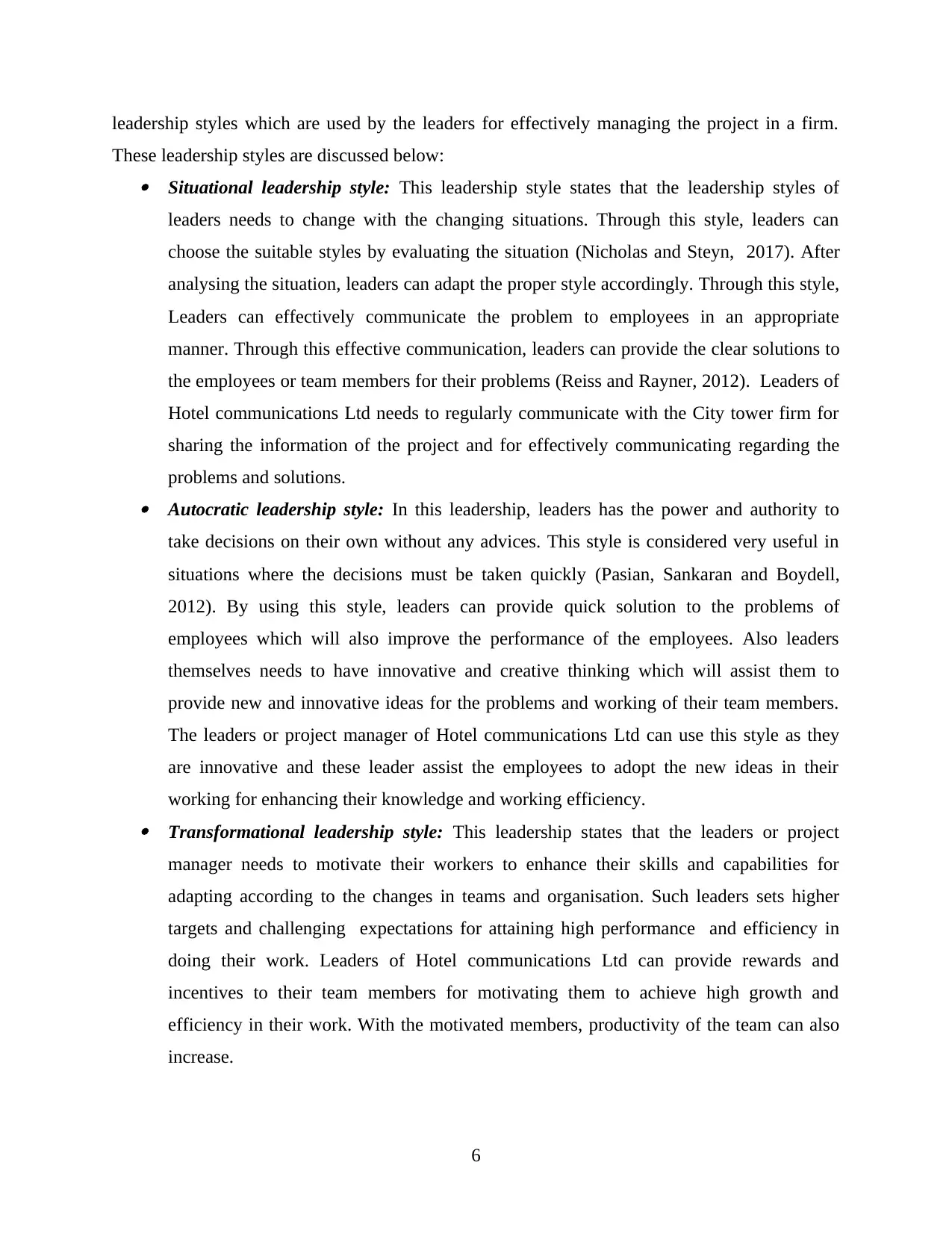
leadership styles which are used by the leaders for effectively managing the project in a firm.
These leadership styles are discussed below: Situational leadership style: This leadership style states that the leadership styles of
leaders needs to change with the changing situations. Through this style, leaders can
choose the suitable styles by evaluating the situation (Nicholas and Steyn, 2017). After
analysing the situation, leaders can adapt the proper style accordingly. Through this style,
Leaders can effectively communicate the problem to employees in an appropriate
manner. Through this effective communication, leaders can provide the clear solutions to
the employees or team members for their problems (Reiss and Rayner, 2012). Leaders of
Hotel communications Ltd needs to regularly communicate with the City tower firm for
sharing the information of the project and for effectively communicating regarding the
problems and solutions. Autocratic leadership style: In this leadership, leaders has the power and authority to
take decisions on their own without any advices. This style is considered very useful in
situations where the decisions must be taken quickly (Pasian, Sankaran and Boydell,
2012). By using this style, leaders can provide quick solution to the problems of
employees which will also improve the performance of the employees. Also leaders
themselves needs to have innovative and creative thinking which will assist them to
provide new and innovative ideas for the problems and working of their team members.
The leaders or project manager of Hotel communications Ltd can use this style as they
are innovative and these leader assist the employees to adopt the new ideas in their
working for enhancing their knowledge and working efficiency. Transformational leadership style: This leadership states that the leaders or project
manager needs to motivate their workers to enhance their skills and capabilities for
adapting according to the changes in teams and organisation. Such leaders sets higher
targets and challenging expectations for attaining high performance and efficiency in
doing their work. Leaders of Hotel communications Ltd can provide rewards and
incentives to their team members for motivating them to achieve high growth and
efficiency in their work. With the motivated members, productivity of the team can also
increase.
6
These leadership styles are discussed below: Situational leadership style: This leadership style states that the leadership styles of
leaders needs to change with the changing situations. Through this style, leaders can
choose the suitable styles by evaluating the situation (Nicholas and Steyn, 2017). After
analysing the situation, leaders can adapt the proper style accordingly. Through this style,
Leaders can effectively communicate the problem to employees in an appropriate
manner. Through this effective communication, leaders can provide the clear solutions to
the employees or team members for their problems (Reiss and Rayner, 2012). Leaders of
Hotel communications Ltd needs to regularly communicate with the City tower firm for
sharing the information of the project and for effectively communicating regarding the
problems and solutions. Autocratic leadership style: In this leadership, leaders has the power and authority to
take decisions on their own without any advices. This style is considered very useful in
situations where the decisions must be taken quickly (Pasian, Sankaran and Boydell,
2012). By using this style, leaders can provide quick solution to the problems of
employees which will also improve the performance of the employees. Also leaders
themselves needs to have innovative and creative thinking which will assist them to
provide new and innovative ideas for the problems and working of their team members.
The leaders or project manager of Hotel communications Ltd can use this style as they
are innovative and these leader assist the employees to adopt the new ideas in their
working for enhancing their knowledge and working efficiency. Transformational leadership style: This leadership states that the leaders or project
manager needs to motivate their workers to enhance their skills and capabilities for
adapting according to the changes in teams and organisation. Such leaders sets higher
targets and challenging expectations for attaining high performance and efficiency in
doing their work. Leaders of Hotel communications Ltd can provide rewards and
incentives to their team members for motivating them to achieve high growth and
efficiency in their work. With the motivated members, productivity of the team can also
increase.
6
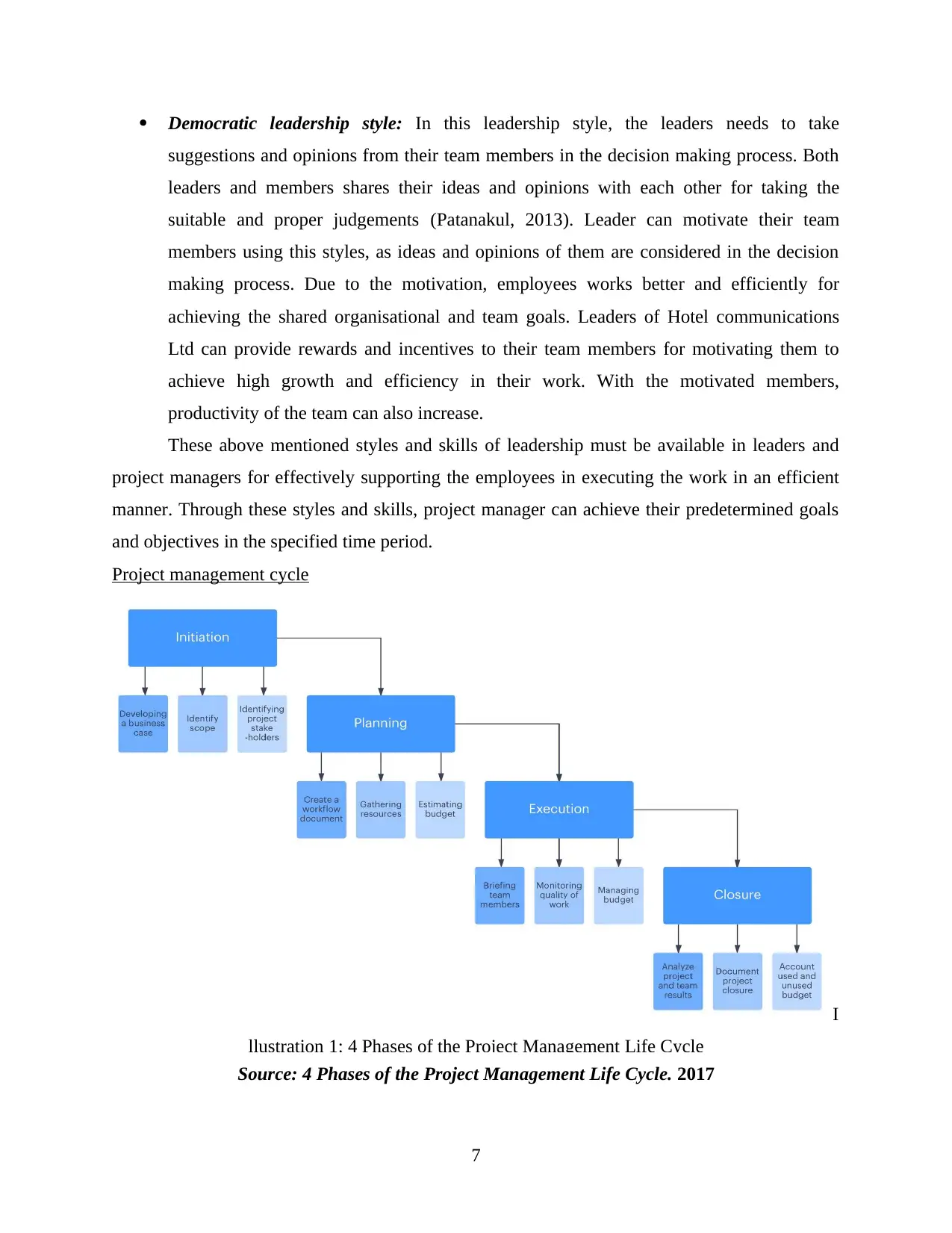
Democratic leadership style: In this leadership style, the leaders needs to take
suggestions and opinions from their team members in the decision making process. Both
leaders and members shares their ideas and opinions with each other for taking the
suitable and proper judgements (Patanakul, 2013). Leader can motivate their team
members using this styles, as ideas and opinions of them are considered in the decision
making process. Due to the motivation, employees works better and efficiently for
achieving the shared organisational and team goals. Leaders of Hotel communications
Ltd can provide rewards and incentives to their team members for motivating them to
achieve high growth and efficiency in their work. With the motivated members,
productivity of the team can also increase.
These above mentioned styles and skills of leadership must be available in leaders and
project managers for effectively supporting the employees in executing the work in an efficient
manner. Through these styles and skills, project manager can achieve their predetermined goals
and objectives in the specified time period.
Project management cycle
Source: 4 Phases of the Project Management Life Cycle. 2017
7
I
llustration 1: 4 Phases of the Project Management Life Cycle
suggestions and opinions from their team members in the decision making process. Both
leaders and members shares their ideas and opinions with each other for taking the
suitable and proper judgements (Patanakul, 2013). Leader can motivate their team
members using this styles, as ideas and opinions of them are considered in the decision
making process. Due to the motivation, employees works better and efficiently for
achieving the shared organisational and team goals. Leaders of Hotel communications
Ltd can provide rewards and incentives to their team members for motivating them to
achieve high growth and efficiency in their work. With the motivated members,
productivity of the team can also increase.
These above mentioned styles and skills of leadership must be available in leaders and
project managers for effectively supporting the employees in executing the work in an efficient
manner. Through these styles and skills, project manager can achieve their predetermined goals
and objectives in the specified time period.
Project management cycle
Source: 4 Phases of the Project Management Life Cycle. 2017
7
I
llustration 1: 4 Phases of the Project Management Life Cycle
⊘ This is a preview!⊘
Do you want full access?
Subscribe today to unlock all pages.

Trusted by 1+ million students worldwide
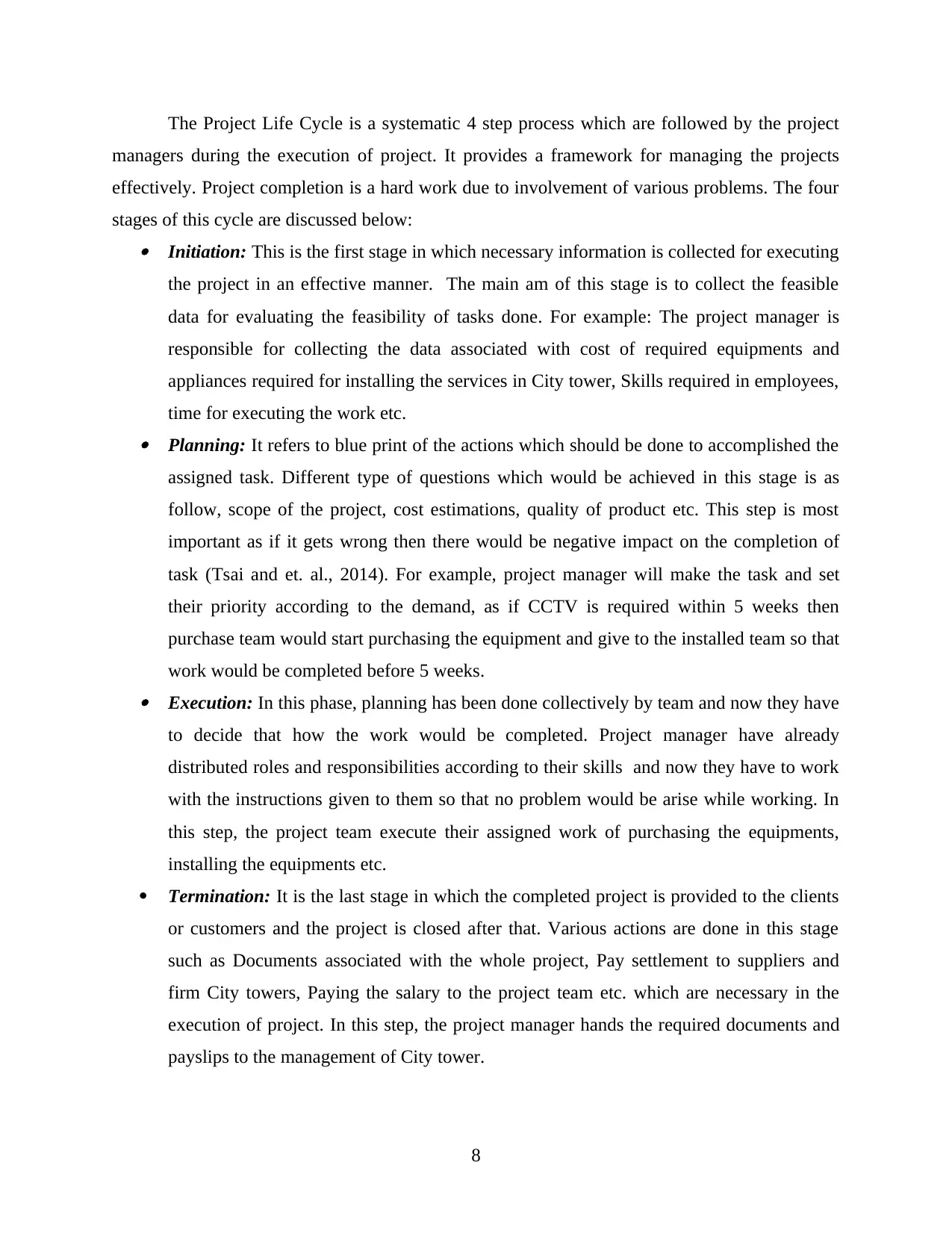
The Project Life Cycle is a systematic 4 step process which are followed by the project
managers during the execution of project. It provides a framework for managing the projects
effectively. Project completion is a hard work due to involvement of various problems. The four
stages of this cycle are discussed below: Initiation: This is the first stage in which necessary information is collected for executing
the project in an effective manner. The main am of this stage is to collect the feasible
data for evaluating the feasibility of tasks done. For example: The project manager is
responsible for collecting the data associated with cost of required equipments and
appliances required for installing the services in City tower, Skills required in employees,
time for executing the work etc. Planning: It refers to blue print of the actions which should be done to accomplished the
assigned task. Different type of questions which would be achieved in this stage is as
follow, scope of the project, cost estimations, quality of product etc. This step is most
important as if it gets wrong then there would be negative impact on the completion of
task (Tsai and et. al., 2014). For example, project manager will make the task and set
their priority according to the demand, as if CCTV is required within 5 weeks then
purchase team would start purchasing the equipment and give to the installed team so that
work would be completed before 5 weeks. Execution: In this phase, planning has been done collectively by team and now they have
to decide that how the work would be completed. Project manager have already
distributed roles and responsibilities according to their skills and now they have to work
with the instructions given to them so that no problem would be arise while working. In
this step, the project team execute their assigned work of purchasing the equipments,
installing the equipments etc.
Termination: It is the last stage in which the completed project is provided to the clients
or customers and the project is closed after that. Various actions are done in this stage
such as Documents associated with the whole project, Pay settlement to suppliers and
firm City towers, Paying the salary to the project team etc. which are necessary in the
execution of project. In this step, the project manager hands the required documents and
payslips to the management of City tower.
8
managers during the execution of project. It provides a framework for managing the projects
effectively. Project completion is a hard work due to involvement of various problems. The four
stages of this cycle are discussed below: Initiation: This is the first stage in which necessary information is collected for executing
the project in an effective manner. The main am of this stage is to collect the feasible
data for evaluating the feasibility of tasks done. For example: The project manager is
responsible for collecting the data associated with cost of required equipments and
appliances required for installing the services in City tower, Skills required in employees,
time for executing the work etc. Planning: It refers to blue print of the actions which should be done to accomplished the
assigned task. Different type of questions which would be achieved in this stage is as
follow, scope of the project, cost estimations, quality of product etc. This step is most
important as if it gets wrong then there would be negative impact on the completion of
task (Tsai and et. al., 2014). For example, project manager will make the task and set
their priority according to the demand, as if CCTV is required within 5 weeks then
purchase team would start purchasing the equipment and give to the installed team so that
work would be completed before 5 weeks. Execution: In this phase, planning has been done collectively by team and now they have
to decide that how the work would be completed. Project manager have already
distributed roles and responsibilities according to their skills and now they have to work
with the instructions given to them so that no problem would be arise while working. In
this step, the project team execute their assigned work of purchasing the equipments,
installing the equipments etc.
Termination: It is the last stage in which the completed project is provided to the clients
or customers and the project is closed after that. Various actions are done in this stage
such as Documents associated with the whole project, Pay settlement to suppliers and
firm City towers, Paying the salary to the project team etc. which are necessary in the
execution of project. In this step, the project manager hands the required documents and
payslips to the management of City tower.
8
Paraphrase This Document
Need a fresh take? Get an instant paraphrase of this document with our AI Paraphraser
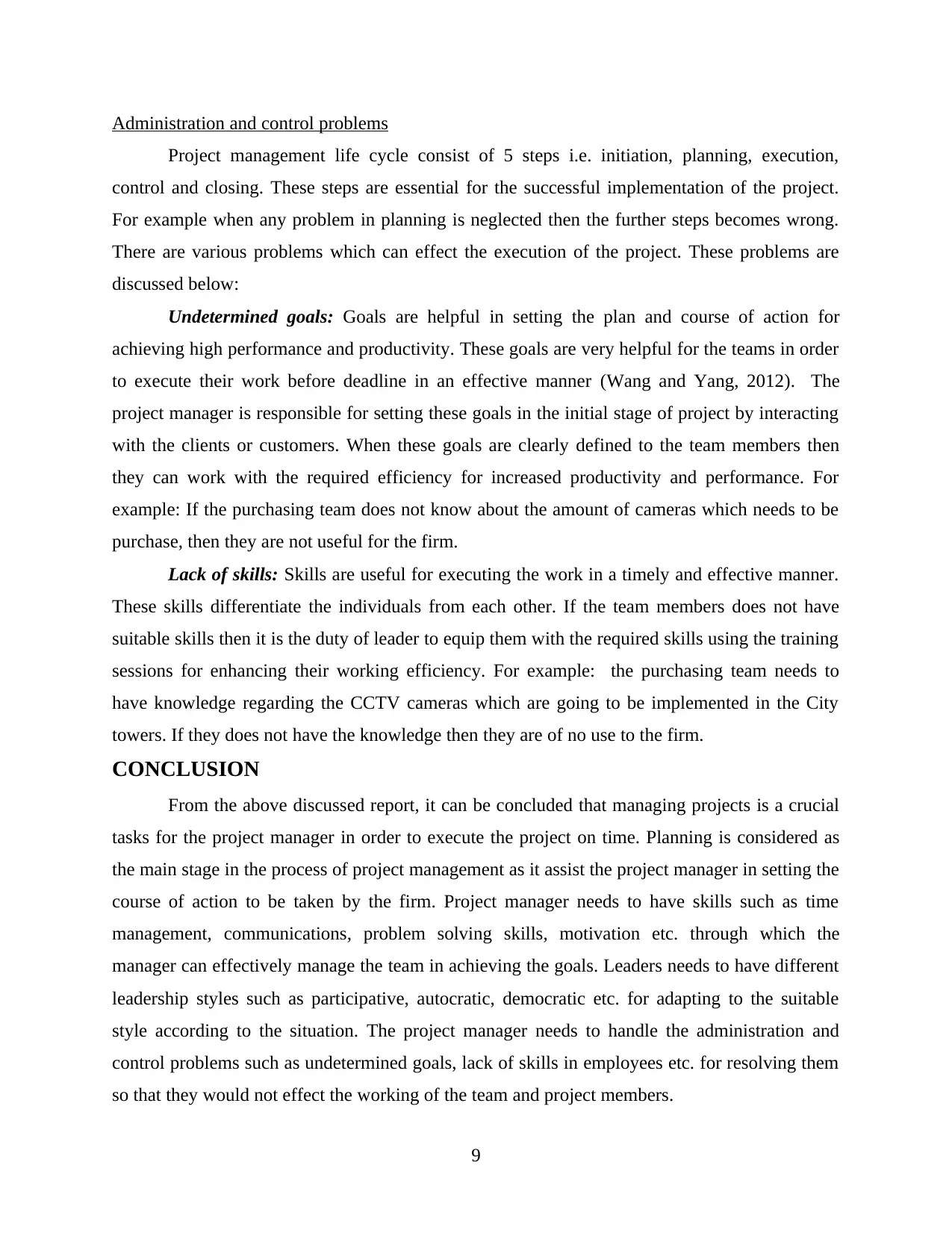
Administration and control problems
Project management life cycle consist of 5 steps i.e. initiation, planning, execution,
control and closing. These steps are essential for the successful implementation of the project.
For example when any problem in planning is neglected then the further steps becomes wrong.
There are various problems which can effect the execution of the project. These problems are
discussed below:
Undetermined goals: Goals are helpful in setting the plan and course of action for
achieving high performance and productivity. These goals are very helpful for the teams in order
to execute their work before deadline in an effective manner (Wang and Yang, 2012). The
project manager is responsible for setting these goals in the initial stage of project by interacting
with the clients or customers. When these goals are clearly defined to the team members then
they can work with the required efficiency for increased productivity and performance. For
example: If the purchasing team does not know about the amount of cameras which needs to be
purchase, then they are not useful for the firm.
Lack of skills: Skills are useful for executing the work in a timely and effective manner.
These skills differentiate the individuals from each other. If the team members does not have
suitable skills then it is the duty of leader to equip them with the required skills using the training
sessions for enhancing their working efficiency. For example: the purchasing team needs to
have knowledge regarding the CCTV cameras which are going to be implemented in the City
towers. If they does not have the knowledge then they are of no use to the firm.
CONCLUSION
From the above discussed report, it can be concluded that managing projects is a crucial
tasks for the project manager in order to execute the project on time. Planning is considered as
the main stage in the process of project management as it assist the project manager in setting the
course of action to be taken by the firm. Project manager needs to have skills such as time
management, communications, problem solving skills, motivation etc. through which the
manager can effectively manage the team in achieving the goals. Leaders needs to have different
leadership styles such as participative, autocratic, democratic etc. for adapting to the suitable
style according to the situation. The project manager needs to handle the administration and
control problems such as undetermined goals, lack of skills in employees etc. for resolving them
so that they would not effect the working of the team and project members.
9
Project management life cycle consist of 5 steps i.e. initiation, planning, execution,
control and closing. These steps are essential for the successful implementation of the project.
For example when any problem in planning is neglected then the further steps becomes wrong.
There are various problems which can effect the execution of the project. These problems are
discussed below:
Undetermined goals: Goals are helpful in setting the plan and course of action for
achieving high performance and productivity. These goals are very helpful for the teams in order
to execute their work before deadline in an effective manner (Wang and Yang, 2012). The
project manager is responsible for setting these goals in the initial stage of project by interacting
with the clients or customers. When these goals are clearly defined to the team members then
they can work with the required efficiency for increased productivity and performance. For
example: If the purchasing team does not know about the amount of cameras which needs to be
purchase, then they are not useful for the firm.
Lack of skills: Skills are useful for executing the work in a timely and effective manner.
These skills differentiate the individuals from each other. If the team members does not have
suitable skills then it is the duty of leader to equip them with the required skills using the training
sessions for enhancing their working efficiency. For example: the purchasing team needs to
have knowledge regarding the CCTV cameras which are going to be implemented in the City
towers. If they does not have the knowledge then they are of no use to the firm.
CONCLUSION
From the above discussed report, it can be concluded that managing projects is a crucial
tasks for the project manager in order to execute the project on time. Planning is considered as
the main stage in the process of project management as it assist the project manager in setting the
course of action to be taken by the firm. Project manager needs to have skills such as time
management, communications, problem solving skills, motivation etc. through which the
manager can effectively manage the team in achieving the goals. Leaders needs to have different
leadership styles such as participative, autocratic, democratic etc. for adapting to the suitable
style according to the situation. The project manager needs to handle the administration and
control problems such as undetermined goals, lack of skills in employees etc. for resolving them
so that they would not effect the working of the team and project members.
9
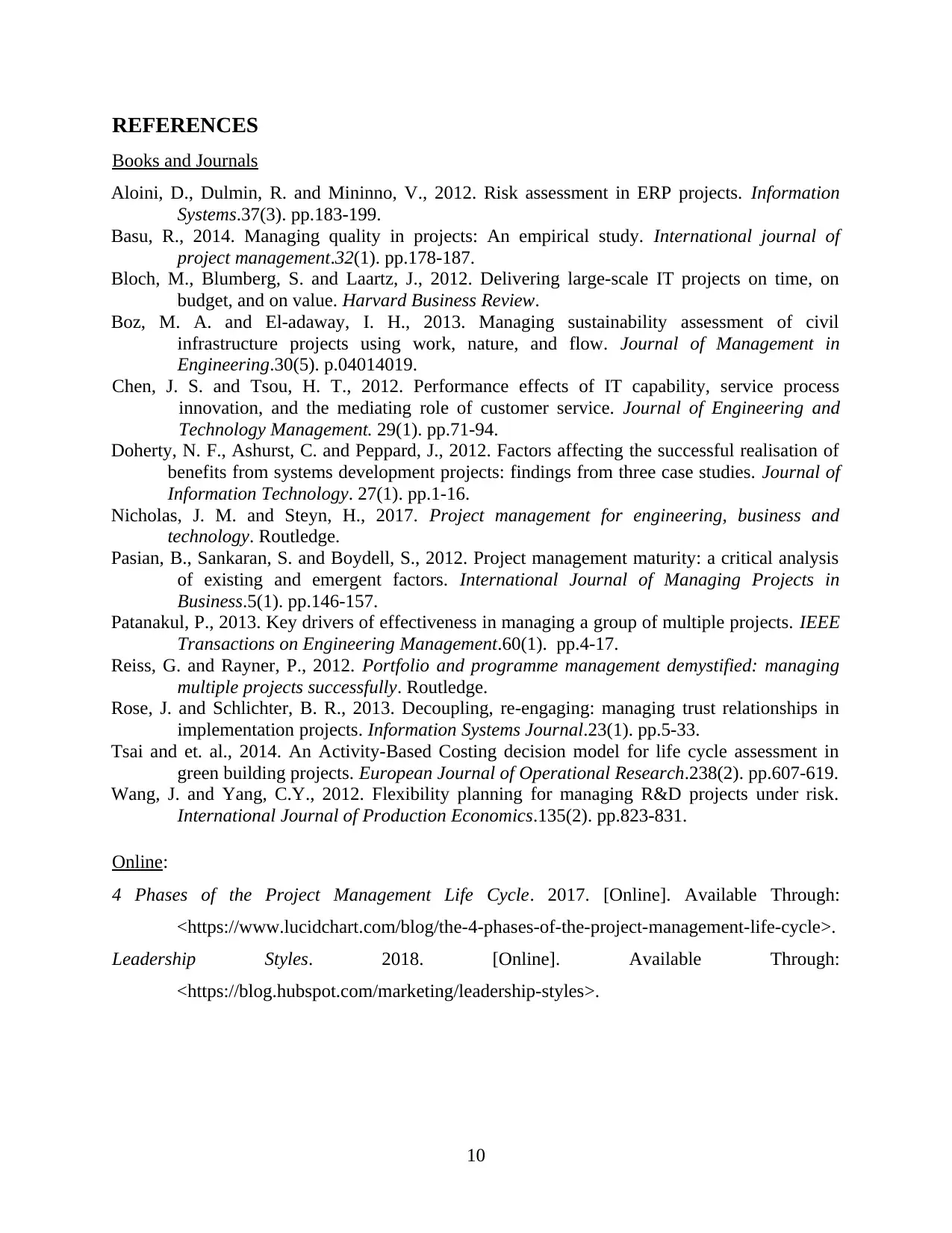
REFERENCES
Books and Journals
Aloini, D., Dulmin, R. and Mininno, V., 2012. Risk assessment in ERP projects. Information
Systems.37(3). pp.183-199.
Basu, R., 2014. Managing quality in projects: An empirical study. International journal of
project management.32(1). pp.178-187.
Bloch, M., Blumberg, S. and Laartz, J., 2012. Delivering large-scale IT projects on time, on
budget, and on value. Harvard Business Review.
Boz, M. A. and El-adaway, I. H., 2013. Managing sustainability assessment of civil
infrastructure projects using work, nature, and flow. Journal of Management in
Engineering.30(5). p.04014019.
Chen, J. S. and Tsou, H. T., 2012. Performance effects of IT capability, service process
innovation, and the mediating role of customer service. Journal of Engineering and
Technology Management. 29(1). pp.71-94.
Doherty, N. F., Ashurst, C. and Peppard, J., 2012. Factors affecting the successful realisation of
benefits from systems development projects: findings from three case studies. Journal of
Information Technology. 27(1). pp.1-16.
Nicholas, J. M. and Steyn, H., 2017. Project management for engineering, business and
technology. Routledge.
Pasian, B., Sankaran, S. and Boydell, S., 2012. Project management maturity: a critical analysis
of existing and emergent factors. International Journal of Managing Projects in
Business.5(1). pp.146-157.
Patanakul, P., 2013. Key drivers of effectiveness in managing a group of multiple projects. IEEE
Transactions on Engineering Management.60(1). pp.4-17.
Reiss, G. and Rayner, P., 2012. Portfolio and programme management demystified: managing
multiple projects successfully. Routledge.
Rose, J. and Schlichter, B. R., 2013. Decoupling, re‐engaging: managing trust relationships in
implementation projects. Information Systems Journal.23(1). pp.5-33.
Tsai and et. al., 2014. An Activity-Based Costing decision model for life cycle assessment in
green building projects. European Journal of Operational Research.238(2). pp.607-619.
Wang, J. and Yang, C.Y., 2012. Flexibility planning for managing R&D projects under risk.
International Journal of Production Economics.135(2). pp.823-831.
Online:
4 Phases of the Project Management Life Cycle. 2017. [Online]. Available Through:
<https://www.lucidchart.com/blog/the-4-phases-of-the-project-management-life-cycle>.
Leadership Styles. 2018. [Online]. Available Through:
<https://blog.hubspot.com/marketing/leadership-styles>.
10
Books and Journals
Aloini, D., Dulmin, R. and Mininno, V., 2012. Risk assessment in ERP projects. Information
Systems.37(3). pp.183-199.
Basu, R., 2014. Managing quality in projects: An empirical study. International journal of
project management.32(1). pp.178-187.
Bloch, M., Blumberg, S. and Laartz, J., 2012. Delivering large-scale IT projects on time, on
budget, and on value. Harvard Business Review.
Boz, M. A. and El-adaway, I. H., 2013. Managing sustainability assessment of civil
infrastructure projects using work, nature, and flow. Journal of Management in
Engineering.30(5). p.04014019.
Chen, J. S. and Tsou, H. T., 2012. Performance effects of IT capability, service process
innovation, and the mediating role of customer service. Journal of Engineering and
Technology Management. 29(1). pp.71-94.
Doherty, N. F., Ashurst, C. and Peppard, J., 2012. Factors affecting the successful realisation of
benefits from systems development projects: findings from three case studies. Journal of
Information Technology. 27(1). pp.1-16.
Nicholas, J. M. and Steyn, H., 2017. Project management for engineering, business and
technology. Routledge.
Pasian, B., Sankaran, S. and Boydell, S., 2012. Project management maturity: a critical analysis
of existing and emergent factors. International Journal of Managing Projects in
Business.5(1). pp.146-157.
Patanakul, P., 2013. Key drivers of effectiveness in managing a group of multiple projects. IEEE
Transactions on Engineering Management.60(1). pp.4-17.
Reiss, G. and Rayner, P., 2012. Portfolio and programme management demystified: managing
multiple projects successfully. Routledge.
Rose, J. and Schlichter, B. R., 2013. Decoupling, re‐engaging: managing trust relationships in
implementation projects. Information Systems Journal.23(1). pp.5-33.
Tsai and et. al., 2014. An Activity-Based Costing decision model for life cycle assessment in
green building projects. European Journal of Operational Research.238(2). pp.607-619.
Wang, J. and Yang, C.Y., 2012. Flexibility planning for managing R&D projects under risk.
International Journal of Production Economics.135(2). pp.823-831.
Online:
4 Phases of the Project Management Life Cycle. 2017. [Online]. Available Through:
<https://www.lucidchart.com/blog/the-4-phases-of-the-project-management-life-cycle>.
Leadership Styles. 2018. [Online]. Available Through:
<https://blog.hubspot.com/marketing/leadership-styles>.
10
⊘ This is a preview!⊘
Do you want full access?
Subscribe today to unlock all pages.

Trusted by 1+ million students worldwide
1 out of 12
Related Documents
Your All-in-One AI-Powered Toolkit for Academic Success.
+13062052269
info@desklib.com
Available 24*7 on WhatsApp / Email
![[object Object]](/_next/static/media/star-bottom.7253800d.svg)
Unlock your academic potential
Copyright © 2020–2025 A2Z Services. All Rights Reserved. Developed and managed by ZUCOL.





